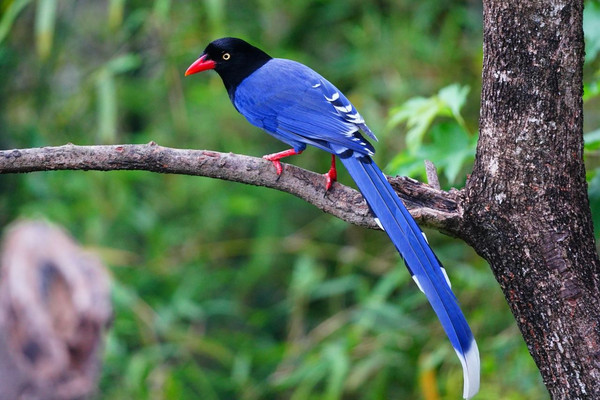Mikado Pheasant
Taiwan – The Land of Endemics

Operations Assistant
19th May 2021
Only marginally larger in length than the Republic of Ireland, its range of distinct habitats, which includes mountains with steep-sided slopes shrouded in lush forest, lowlands supporting tidal estuaries and cultivated farmlands, each supports a diverse array of avifauna!
Operations Assistant, Matt Eade, describes the highlights of our popular birdwatching holiday here.
Similar to other endemic-rich islands, it is the mountains where many of these birds reside. Taiwan’s spectacular mountain range (the highest peak of Yushan is just under 13,000 ft.) spans from the north-east corner then south to the centre and supports no fewer than 20 endemic birds (dependent on which taxonomy one is using), plus a staggering number of endemic sub-species.
The country’s excellent infrastructure allows easy access to the best birdwatching areas, whether this is visiting the wader-rich coastal estuaries, or the endemic-rich highlands for their superb duo of pheasants and other hidden gems, which may include the stunning Taiwan Blue Magpie! Visiting both of these key habitats ensures that over 200 species of bird can be found in a relatively short time frame, and with excellent local cuisine and fine hotels, this is set to be a brilliant trip to Asia’s far east.

Upon landing at the north of the island, not far from the spectacular conurbation of Taipei, the true sense of east Asian birding commences, as a short visit to the coast provides ample opportunity to find the likes of Japanese Bush Warbler, Dusky and Pale Thrush, Chinese Bulbul and Eastern Spot-billed Duck.
However, moving inland towards the foothills will see the first of the 22 Taiwanese endemics. In the cultivated lowlands, Taiwan Hwamei ‘blast-out’ their melodic songs from roadside wires. Taiwan Barbet – another impressive endemic – is also found in the lowlands, and despite its monotonous call, its plumage and characteristics provide much attraction for the onlooker. Both Taiwan and Black-necklaced Scimitar-babblers, each as striking as one another, will require much patience to honour the sheer beauty of these specialist skulkers.
A full two days will be enjoyed in the Dasyueshan Mountains; steep-sided valleys here are swathed in dense deciduous forest, home to a whole cast of wintering east Asian passerines and, of course, a plethora of endemic birdlife. Due to the stark difference in altitude over a short period of time, the first day in the range will be amongst the lower elevations, while the next day will be level with the coniferous treeline, where temperatures plummet and the avifauna changes dramatically.

The ascent will provide ample opportunity to search the rampant rivers for Brown Dippers, Plumbeous Water Redstarts, Striated Herons, and possibly, Taiwan Whistling Thrush – a superb handful of species which can be numerous in this habitat – while throughout the winter and early spring months, passerines form vast mixed-species flocks: Taiwan Yuhina, Black-throated Tit, Rufous-faced Warbler and White-bellied Erpornis are just a few of the species that form these energetic flocks.
Like many east Asian countries, it is the ground-dwelling birds that provide much anticipation for the birding community, and Taiwan is no exception. Two species of pheasant – both striking in plumage – roam these hillsides, and feeding stations ensure that both the Swinhoe’s and Mikado Pheasant perform admirably for their admirers as they feed along the mountainous roadside – both can almost be described as guaranteed!
Large clearings amongst the higher altitudes are the perfect viewing platform to observe a variety of tree-dwelling birds. Steere’s Liocichla, despite their elusive nature, often perform well, while Yellow Tit, Taiwan Barwing, White-eared Sibia, Island Thrush and Rufous-crowned Laughingthrush can usually be found too. Skulking, yet beautiful, Collared Bush Robins can be seen across the mid-elevations, and the high-pitched whistling of Taiwan Wren Babblers will pose a huge challenge to find as they discreetly hop about the dense understorey.

Encroaching the edge of the now coniferous treeline and single-figured temperatures will reveal marvellous views across this extensive mountain range; bamboo thickets provide an opportunity to discover small fast-moving flocks of Golden Parrotbills; diminutive Flamecrests are duly found in the conifer stands and Taiwan Fulvettas are in the swathes of low scrub which cover the higher slopes. Resident Nutcrackers and Alpine Accentors – due to be split into their own species – are other delights to be found here. Formosan Macaques are very apparent here too.
Out of the mountains and along the sweltering west coast, the large expanse of wetlands at Budai, situated on the west side of the island, provides much variation to the itinerary, and although no endemics are found here, it is one of few sites on the planet where the critically-endangered Black-faced Spoonbill is found. This impressive bird, which is like its European counterpart, has an overall world population of only 5,000 individuals. As well as the privilege of watching the spoonbills, myriad wader species are also found here, as Sharp-tailed Sandpipers, Red-necked and Long-toed Stints, Lesser Sand Plovers and Pacific Golden Plovers are all numerous, and on rare occasions, Spoon-billed Sandpipers have also turned up.
The journey back north through the lower foothills of the Alishan region provides ample opportunity to target those species one may have missed the first time, and also allows time to view the final endemic – Styan’s Bulbul. The foothills around this famous region can also provide some of the country’s best birding; gardens can become vibrant with bird activity as Taiwan Barbet, Vinous-throated Parrotbill, Black-throated Tit, Pechora Pipit, Rusty Laughingthrush and Collared Finchbill all feed here, whilst Black Eagle is a common encounter overhead. Sampling the local tea is also an activity not to be missed during the quiet afternoons, and at night, excursions into the forest may reveal the White-faced Flying Squirrel!
Several small towns and villages will be driven through during the return to the capital, enabling an insight into Taiwanese life and a short interlude to observe the variety of temples here – one of which is the site of a Collared Scops Owl roost!
This 10-day wildlife holiday is set to be a relaxing, yet bird-filled trip, where little travelling is required to reach some of the best birdwatching destinations in the entirety of east Asia! For more information, please visit the tour page.





 Loading search...
Loading search...